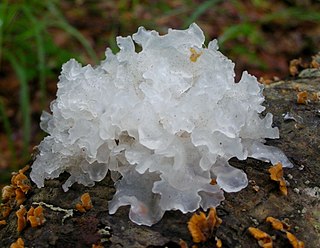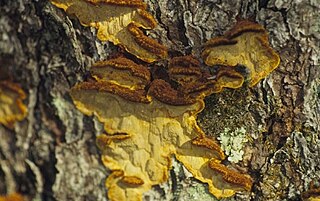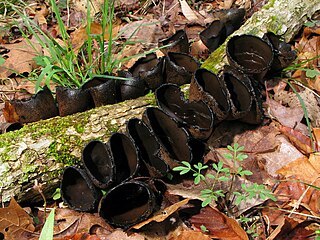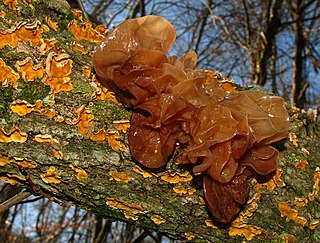
Jelly fungi are a paraphyletic group of several heterobasidiomycete fungal orders from different classes of the subphylum Agaricomycotina: Tremellales, Dacrymycetales, Auriculariales and Sebacinales. These fungi are so named because their foliose, irregularly branched fruiting body is, or appears to be, the consistency of jelly. Actually, many are somewhat rubbery and gelatinous. When dried, jelly fungi become hard and shriveled; when exposed to water, they return to their original form.

Tremella fuciformis is a species of fungus; it produces white, frond-like, gelatinous basidiocarps. It is widespread, especially in the tropics, where it can be found on the dead branches of broadleaf trees. This fungus is commercially cultivated and is one of the most popular fungi in the cuisine and medicine of China. T. fuciformis is commonly known as snow fungus, snow ear, silver ear fungus, white jelly mushroom, and white cloud ears.

The Leotiomycetes are a class of ascomycete fungi. Many of them cause serious plant diseases.
Clonostachys rosea f. rosea, also known as Gliocladium roseum, is a species of fungus in the family Bionectriaceae. It colonizes living plants as an endophyte, digests material in soil as a saprophyte and is also known as a parasite of other fungi and of nematodes. It produces a wide range of volatile organic compounds which are toxic to organisms including other fungi, bacteria, and insects, and is of interest as a biological pest control agent.

Stereum sanguinolentum is a species of fungus in the Stereaceae family. A plant pathogen, it causes red heart rot, a red discoloration on conifers, particularly spruces or Douglas-firs. Fruit bodies are produced on dead wood, or sometimes on dead branches of living trees. They are a thin leathery crust of the wood surface. Fresh fruit bodies will bleed a red-colored juice if injured, reflected in the common names bleeding Stereum or the bleeding conifer parchment. It can be the host of the parasitic jelly fungus Tremella encephala.

Porodaedalea pini, commonly known as the pine conk, is a species of fungus in the family Hymenochaetaceae. It is a plant pathogen that causes tree disease commonly known as "red ring rot" or "white speck". This disease, extremely common in the conifers of North America, decays tree trunks, rendering them useless for lumber. It is a rot of the heartwood. Signs of the fungus include shelf-shaped conks protruding from the trunks of trees. Spores produced on these conks are blown by the wind and infect other trees. Formal management of this disease is limited, and the disease is controlled primarily by cultural practices. Red ring rot is an important forest disturbance agent and plays a key role in habitat formation for several forest animals.

Meripilus giganteus is a polypore fungus in the family Meripilaceae. It causes a white rot in various types of broadleaved trees, particularly beech (Fagus), but also Abies, Picea, Pinus, Quercus and Ulmus species. This bracket fungus, commonly known as the giant polypore or black-staining polypore, is often found in large clumps at the base of trees, although fruiting bodies are sometimes found some distance away from the trunk, parasitizing the roots. M. giganteus has a circumboreal distribution in the northern Hemisphere, and is widely distributed in Europe. In the field, it is recognizable by the large, multi-capped fruiting body, as well as its pore surface that quickly darkens black when bruised or injured.

Auricularia is a genus of fungi in the family Auriculariaceae. Basidiocarps are typically gelatinous and ear-shaped, with a slightly downy to conspicuously hirsute upper surface and an under surface that is smooth, wrinkled or veined. All species grow on wood. Several Auricularia species are edible and commercially cultivated on a large scale in China and East Asia.

Scutellinia scutellata, commonly known as the eyelash pixie cup, eyelash cup, the Molly eye-winker, the scarlet elf cap, the eyelash fungus or the eyelash pixie cup, is a small saprophytic fungus of the genus Scutellinia. It is the type species of Scutellinia, as well as being the most common and widespread. The fruiting bodies are small red cups with distinctive long, dark hairs or "eyelashes". These eyelashes are the most distinctive feature and are easily visible with a magnifying glass.

Urnula craterium is a species of cup fungus in the family Sarcosomataceae. Appearing in early spring, its distinctive goblet-shaped and dark-colored fruit bodies have earned it the common names crater cup, devil's urn and the gray urn. The asexual (imperfect), or conidial stage of U. craterium is a plant pathogen known as Conoplea globosa, which causes a canker disease of oak and several other hardwood tree species.

Caloscypha is a fungal genus in the family Caloscyphaceae. A monotypic genus, it contains the single species Caloscypha fulgens, commonly known as the snowbank orange peel fungus, spring orange peel fungus, the golden cup, or the dazzling cup. It is a cup fungus, typically up to 4 centimetres in diameter, with a bright to pale orange interior and orange; specimens that are old or bruised often have an olive-green discoloration, especially around the edges.

Exidia glandulosa, commonly known as black witches' butter, black jelly roll, or warty jelly fungus, is a jelly fungus in the family Auriculariaceae. It is a common, wood-rotting species in Europe, typically growing on dead attached branches of oak. The fruit bodies are up to 3 cm (1.2 in) wide, shiny, black and blister-like, and grow singly or in clusters. Its occurrence elsewhere is uncertain because of confusion with the related species, Exidia nigricans.

Exidia nigricans is a jelly fungus in the family Auriculariaceae. It is a common, wood-rotting species throughout the Northern Hemisphere, typically growing on dead attached branches of broadleaf trees. It has been much confused with Exidia glandulosa.

Myxarium nucleatum is a species of fungus in the family Hyaloriaceae. In the UK, it has been given the recommended English name of crystal brain. The fruit bodies are watery white, pustular or lobed, and gelatinous with small, white, mineral inclusions visible to the naked eye. It is a common, wood-rotting species in Europe, typically growing on dead attached or fallen branches of broadleaf trees. It is currently not clear whether collections from North America and elsewhere represent the same species.

Lentinellus montanus is a species of agaric fungus in the family Auriscalpiaceae. It is found at high elevations in the Pacific Northwest region of North America, where it fruits singly or in clumps on decaying conifer wood.

Auricularia auricula-judae, commonly known as wood ear, jelly ear, or more historically, Jew's ear, is a species of fungus in the order Auriculariales. Basidiocarps are brown, gelatinous, and have a noticeably ear-like shape. They grow on wood, especially elder. The specific epithet is derived from the belief that Judas Iscariot hanged himself from an elder tree.

Phaeotremella frondosa is a species of fungus in the family Phaeotremellaceae producing brownish, frondose, gelatinous basidiocarps. It is widespread in north temperate regions, and is parasitic on other species of fungi that grow on dead attached and recently fallen branches of broadleaf trees.

Phaeotremella foliacea is a species of fungus in the family Phaeotremellaceae. It produces brownish, frondose, gelatinous basidiocarps and is parasitic on the mycelium of Stereum sanguinolentum, a fungus that grows on dead attached and recently fallen branches of conifers. It is widespread in north temperate regions. In the UK it has the recommended English name leafy brain and has also been called jelly leaf and brown witch's butter. Prior to 2017, the name Tremella foliacea was also applied to similar-looking species on broadleaf trees, now distinguished as Phaeotremella frondosa and Phaeotremella fimbriata.
Phaeotremella fimbriata is a species of fungus in the family Phaeotremellaceae. It produces blackish, frondose, gelatinous basidiocarps and is parasitic on the mycelium of Stereum rugosum, a fungus that grows on dead attached and recently fallen branches of broad-leaved trees. It is widespread in northern Europe. Prior to 2017, the species was generally considered a synonym of Tremella foliacea, but this latter species is restricted to conifers. Phaeotremella frondosa is a similar-looking but paler, brown species on broad-leaved trees and occurs in North America as well as Europe.
Tremella yokohamensis is a species of fungus in the family Tremellaceae. It produces white, foliaceous, gelatinous basidiocarps and is parasitic on other fungi on dead wood of broad-leaved trees. It was originally described from Japan.






















